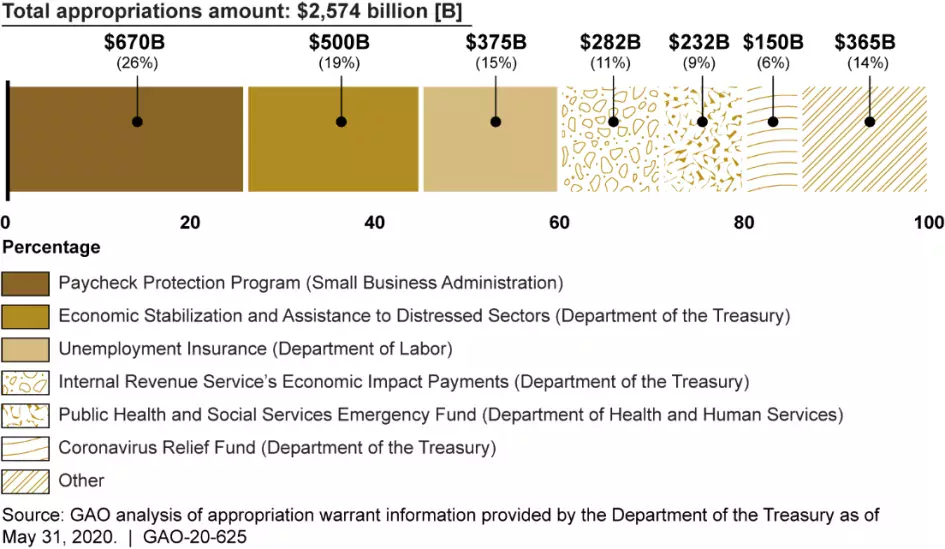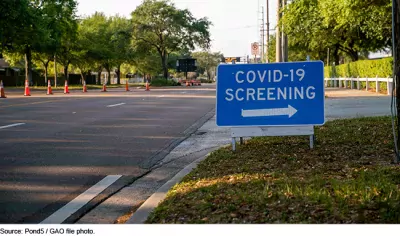GAO’s review of the federal response to COVID-19
Facing unprecedented national public health and economic crises caused by the COVID-19 pandemic, federal agencies moved swiftly to distribute funds and implement programs to help people and businesses. But, as a tradeoff for that speedy response, agencies have made only limited progress so far in achieving transparency and accountability goals.
On June 25, we issued our first audit report on the federal response to COVID-19 under the Coronavirus Aid, Relief, and Economic Security Act (CARES Act) and other relief laws. The CARES Act requires GAO to issue bi-monthly reports through the first year of the law, in addition to several other related studies. Today’s WatchBlog explores what we’ve found so far.
The response to COVID-19
In response to the coronavirus pandemic, Congress enacted 4 relief laws as of June 2020, including the CARES Act. These laws have appropriated about $2.6 trillion in relief funds across the federal government.
Six areas of spending account for about 85% of the total appropriation for COVID-19 health and economic relief, as of May 2020. It is important to note, however, that total federal spending data are not yet available because federal agencies are not required to report spending until June 30, 2020.
The figure below shows appropriation for COVID-19 relief as of May 2020.
Our review and what we found
In our first report, we provide Congress with information and some recommendations on topics such as:
- COVID-19 testing. We found that the Centers for Disease Control (CDC)has not maintained complete or consistent data on the amount of COVID-19 testing that has been done nationwide. As a result, it has been harder to track infections, mitigate effects, and make decisions on when to reopen communities. However, on June 4, the Department of Health and Human Services issued guidance to laboratories that identifies required data reporting standards related to national testing. We will continue to examine coronavirus-related testing activities for future reports.
COVID-19 Drive-Thru Testing in Tampa, FL
- Distribution of supplies. The need for critical equipment and supplies to respond to COVID-19 across the nation quickly exceeded availability in the Strategic National Stockpile. The Department of Health and Human Services (HHS) has worked with the Federal Emergency Management Agency (FEMA) and the Department of Defense to make more supplies available. However, federal, state, and local officials have expressed concerns about the distribution, acquisition, and adequacy of those supplies. We will continue to examine these issues as well as the administration’s efforts to monitor and address stockpile needs.
- Economic impact payments. The Internal Revenue Service (IRS) and the Department of Treasury disbursed 160.4 million payments worth $269.3 billion. However, the agencies had trouble delivering payments to some individuals, risking fraud and making payments to ineligible individuals. For example, according to the Treasury’s Inspector General, as of April 30, almost 1.1 million payments totaling nearly $1.4 billion had gone to deceased people. GAO recommends that IRS consider cost-effective options for notifying ineligible recipients on how to return payments.
- Paycheck Protection Program (PPP). As of May 30, the Small Business Administration (SBA) processed more than $512 billion in 4.6 million guaranteed loans through private lenders to small businesses and other organizations adversely affected by COVID-19. SBA moved quickly to establish a new nationwide program, but this hastened pace contributed to confusion and questions about the program and raised program integrity concerns.
Borrowers and lenders raised a number of questions about the program and eligibility criteria, leading the SBA and the Treasury to issue a number of interim final rules and several versions of responses to frequently asked questions (see figure). However, questions and confusion remained. In June 2020, Congress enacted the Paycheck Protection Program Flexibility Act of 2020, which clarified several key program components.
In addition, to help quickly disburse funds, SBA allowed lenders to rely on borrower certifications to determine borrowers’ eligibility, increasing the potential for fraud. GAO recommends that SBA develop and implement plans to identify and respond to risks in the PPP program to ensure program integrity, achieve program effectiveness, and address potential fraud.
How can you find out more about GAO’s work on the CARES Act and coronavirus?
- Live Feed of Reports: Embed our feed on your website. It will be updated with new reports as they are published.
- Daily Emails: Sign up for our daily emails on this topic or several others.
- Twitter: The fastest way to know we have issued new work is to follow us on Twitter @usgao.
- Open Recommendations: Keep track of related open recommendations.
- Blog Posts: Subscribe to our WatchBlog for the latest COVID-19 posts.
- Previously Issued Work by Topic: Take a look at our section on Past Pandemic-Related Reports.
How can you report suspected fraud to GAO?
It can be challenging to identify where to report your concerns when you have an allegation of fraud, waste, or abuse. But you can report any of your concerns related to the COVID-19 pandemic or the CARES Act to GAO’s FraudNet.
Use any of these 3 methods for reporting your concerns to FraudNet:
- Our online reporting portal
- Via email at Fraud@gao.gov
- Or by calling our hotline at 1-800-424-5454
Due to the coronavirus pandemic and recommendations to practice social distancing, FraudNet staff are working remotely. As a result, we strongly encourage you to submit your concern online so we may provide a more timely response and continue to serve the public.
Comments on GAO’s WatchBlog? Contact blog@gao.gov.
GAO Contacts
Related Products

GAO's mission is to provide Congress with fact-based, nonpartisan information that can help improve federal government performance and ensure accountability for the benefit of the American people. GAO launched its WatchBlog in January, 2014, as part of its continuing effort to reach its audiences—Congress and the American people—where they are currently looking for information.
The blog format allows GAO to provide a little more context about its work than it can offer on its other social media platforms. Posts will tie GAO work to current events and the news; show how GAO’s work is affecting agencies or legislation; highlight reports, testimonies, and issue areas where GAO does work; and provide information about GAO itself, among other things.
Please send any feedback on GAO's WatchBlog to blog@gao.gov.






